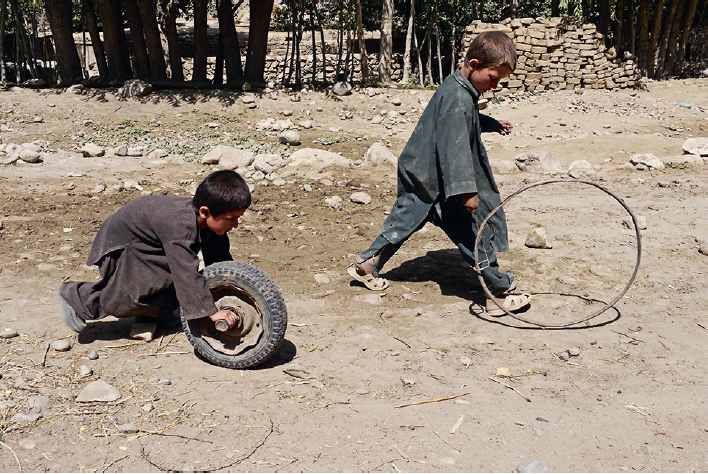Francis Alÿs
For the 16th edition, MOMENTA selected 39 artists whose image-based practice contends with current issues pertaining to political, sociocultural and economic concerns. This year’s biennale of the image, “The Life of Things,” examines our evolving relationship to objects, the changes we instigate in our relationship to our immediate environment and how objects are brought into new perspectives through the image. “Children’s Games” by Francis Alÿs at the Musée d’art contemporain de Montréal proves a highlight of this year’s program by MOMENTA, curated by María Wills Londoño, in collaboration with Audrey Genois, Maude Johnson and MAC curator Mark Lanctôt. It features a selection of 17 video works from a series documenting the rapture of children at play in locations as diverse as Belgium, Morocco and Venezuela. “Children’s Games” opens in a gallery containing two video works, an interstitial space featuring a suspended screen on which one projected video is viewable from either side and a second video on a nearby wall. In the main gallery beyond, a singular cavernous exhibition space accommodates the remaining works. Here, projections line the four walls, and the central space is open yet divided grid-like by additional suspended screens featuring works from the series. Sounds from the videos, each proximal to others, layer in a complex yet unobtrusive manner.

Francis Alÿs, Children’s Games 14 / Piedra, Papel y Tijeras, 2013, video, colour, sound, 2 min, 51 sec. © Francis Alÿs. Images courtesy Musée d’art contemporain de Montréal, Montreal.
The approach adopted by Alÿs in documenting children at play may be considered anthropologic, such is the success of this series. Incidentally, it is not the artist’s sole project of this nature and is preceded by Ambulantes, 1992–, Sleepers, 1999–, and Beggars, 2000–. It is little wonder that the variant occupants of public spaces have captured the artist’s imagination, given that walking in his adopted home of Mexico City, to which he moved from Antwerp in 1987, is paramount to his practice. For those familiar with Alÿs’s oeuvre, “Children’s Games” expertly cues references to the artist’s most iconic performative works. In Children’s Games 1, Caracoles, 1999, a child kicks a partially full soda bottle up the sharp incline of a street, racing to meet the bottle at its apex before it descends and ground is ceded. The chase is sharply reminiscent of If you are a typical spectator, what you are really doing is waiting for the accident to happen, 1996, also in Mexico City. In this work, Alÿs pursues an empty plastic bottle as it is blown through the streets and into the road, where the distracted artist is struck by a passing car. In Kabul, Afghanistan, children chasing inflated inner tubes and rubber tires in Children’s Games 7, Sticks and Wheels, 2010, seem to provide direct inspiration for Reel- Unreal, 2011, in which wheels are replaced by conjoined film reels. These video works distinguish “Children’s Games” as the nexus of concepts the artist has returned to repeatedly, including the staging of fictitious scenarios, repetition, humour, objectives that yield no discernable return and performative actions of socio-political resonance.
Aside from the aerial perspective of Children’s Games 1, Sillas, 2012, and the unflinching framing of hand shadows in Children’s Games 14, Piedra, Papel y Tijeras, 2013, the perspectives in “Children’s Games” are predominantly those of a bystander. Such is the intimacy of the cinematography that the level of detail gleanable would otherwise be available only to a participant. As the viewer becomes absorbed in each vignette, the nuances of children at play begin to surface. In Children’s Games 2, Ricochets, 2007, the mischievous streak of a subject in Tangier is revealed as he adjusts the trajectory of a projectile to travel high above the lake upon which he has been skimming stones, narrowly missing a bird in flight. All boys in frame turn to grin at the camera.

Francis Alÿs, Children’s Games 7 / Hoop and Stick, 2010, video, colour, sound. © Francis Alÿs.
Humour features prominently in this series, as in Children’s Games 3, Piñata, 2012. When the piñata has been grounded and candy exhausted, Alÿs captures a tender moment in which children delight in wearing and scattering the head and appendages of the increasingly fragmented Superman piñata. Momentary glitches in narrative, rousing the viewer from the vicarious revelry of the game, are a stark reminder that locations for these games are commonly unsanctioned public arenas. For example, watching Children’s Games 7: Sticks and Wheels, 2010, a viewer notes time slowing as a running boy in left of frame appears on course to collide with a car, weaving in and out of frame, both heading toward the camera. Calamity is averted as the car careens out of frame and the boy, oblivious, propels his tire onward along the roadside.
The language of play is universal in the broadest sense, and the rules and behaviours governing individual games can be familiar. But recognition of the follies in each game is complicated by geographic context and, again, by the arena of their presentation. Through these lenses, a child felled by a reflection and laying in the doorway of an abandoned building in Children’s Games 15, Espejos, 2013, is a stark reminder of gang violence. Explicit reference is also made to civil unrest, and yet play, an enduring cornerstone of childhood, remains prevalent wherever children congregate. In Children’s Games 16, Hopscotch, 2016, the camera pans to accommodate the Sharya Refugee Camp in Iraq. The grid etched on the ground recollects Israeli artist Sigalit Landau’s Azkelon, 2011, in which children from Gaza and Ashkelon transcend their socio-political context in a game of ‘knives,’ etching imagined territories into the sand on which these districts meet. Even the most comical element of Children’s Games 3, Piñata, 2012, is finally compromised as the camera lingers for a second on a colourful paper appendage floating downstream. In this instance, as elsewhere in his oeuvre, Alÿs toggles deftly—instantaneously— between translations that are at once anecdotal and exigent. ❚
“Children’s Games” was exhibited at the Musée d’art contemporain de Montréal, Montreal, from September 4, 2018, to January 5, 2020.
Jacques Talbot is a Kingston-based writer with interests in photography and installation art.
To read the rest of Issue 152, order a single copy here.

